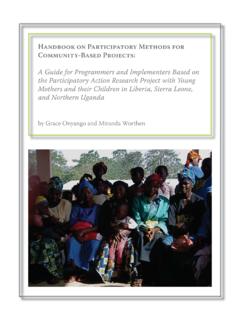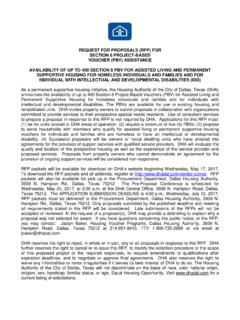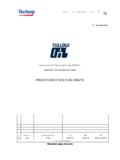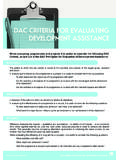Transcription of U.S. DEPARTMENT OF HOUSING AND URBAN DEVELOPMENT
1 DEPARTMENT OF HOUSING AND URBAN DEVELOPMENT WASHINGTON, DC 20410-5000 OFFICE OF PUBLIC AND INDIAN HOUSING OFFICE OF LEAD HAZARD CONTROL AND HEALTHY HOMES _____ Special Attention of: Notice PIH 2017-13 (HA); OHHLHC 2017-01 Office Directors of Public HOUSING ; Regional Directors; Public HOUSING Issued: August 10, 2017 Agencies; HOUSING Choice Voucher Property Owners; Healthy Homes Expires: This notice remains in effect until Representatives, Lead Enforcement amended, superseded or rescinded Analysts _____ Cross References: 24 CFR Part 35 SUBJECT: Guidance on HUD s Lead Safe HOUSING Rule Pertaining to Elevated Blood Lead Levels for the Public HOUSING , HOUSING Choice Voucher, and Project-Based Voucher Programs 1.
2 Purpose This Notice provides general guidance to public HOUSING agencies (PHAs), HOUSING Choice Voucher (HCV) property owners and Project-Based Voucher (PBV) property owners on the required actions they must take when a child in a family receiving public HOUSING , HCV or PBV assistance is identified as having an elevated blood lead level (EBLL). The notice focuses on (but is not limited to) recent changes to HUD s Lead Safe HOUSING Rule (LSHR) as it relates to children identified as an EBLL. The Lead Safe HOUSING Rule is codified as 24 Code of Federal Regulations (CFR) Part 35, subparts B R.
3 This Rule was effective February 13, PHAs were to complete all policy updates and comply with the Rule by July 13, 2017. The LSHR applies to target HOUSING , which, under the LSHR, is any HOUSING constructed prior to 1978, except HOUSING for households for the elderly or persons with disabilities or any 0-bedroom dwelling (unless any child who is less than 6 years of age resides or is expected to reside in such HOUSING ).2 The key changes in the LSHR include revising HUD s Environmental Investigation Blood Lead Level (EIBLL) to the EBLL, enhancing the level of investigation required for a HOUSING unit of a child with an EBLL to an environmental investigation and adding a requirement for testing in other covered units when a child is identified in a multiunit property.
4 This Notice will remain effective until amended, superseded, or rescinded. 1 82 Federal Register 4151, January 13, 2017. 2 If a child under age 6, with or without an EBLL, lives in a 0-bedroom unit or a unit that has been designated for the elderly or persons with disabilities, the unit and the common areas servicing it are covered by not exempt from the LSHR. 2 2. Lead Poisoning Childhood lead poisoning has serious negative consequences on childhood growth and DEVELOPMENT .
5 The Centers for Disease Control and Prevention (CDC) has consistently affirmed that deteriorated lead-based paint and lead-contaminated dust are the most hazardous sources of lead exposure in children. Lead-based paint can be found in homes built before 1978, with an increased prevalence in very old homes with original painted windows, doors, and trim (Jacobs et al., 2002; Cox et al., 2015). In 2012, the CDC lowered its reference level for lead in the blood of children under age 6 to 5 micrograms of lead per deciliter of blood, and provided guidance for health departments and medical professionals at On January 13, 2017, HUD amended the LSHR to align it with CDC s updated guidance.
6 Consistent with CDC s guidance, HUD is now using the reference level of 5 micrograms per deciliter to identify children with an EBLL. This new level is the blood lead level of the highest percent of children ages 1 to 5 years. CDC may revise this level in the future, and if so, HUD will update its EBLL as used under the LSHR, via the notice and comment process, as provided by the definition of EBLL in the amendment (24 CFR ). However, if a state or local government establishes more protective standards in response to lead in children s blood, LSHR s section directs PHAs to follow those standards.
7 3. Key Definitions for this Guidance Assisted Units the Lead Safe HOUSING Rule covers federally-assisted and federally-owned target HOUSING , which includes units assisted under Sections 8 and 9 of the United States HOUSING Act of 1937, as Designated Party for purposes of this Notice, the HOUSING agency or the property owner, as indicated in the applicable section, is responsible for complying with applicable requirements. Elevated Blood-Lead Level (EBLL) - elevated blood lead level means a confirmed concentration of lead in whole blood of a child under age 6 equal to or greater than the concentration in the most recent guidance published by the DEPARTMENT of Health and Human Services (HHS) on recommending that an environmental intervention be conducted.
8 A confirmed concentration is one that is measured by a venous (from a vein) blood draw, and not a finger prick/quick capillary screening test. Environmental Investigation a risk assessment with additional questions for the family regarding other sources of lead exposure ( , water, pottery, daycare settings), and testing of 3 In the case of local non-traditional activities under the Moving to Work Demonstration Program, this includes units funded by Sections 8 and 9. 3 other potential sources of lead exposure in accordance with Chapter 16, Investigation And Treatment Of Dwellings That House Children With Elevated Blood Lead Levels, of HUD s Guidelines for the Evaluation and Control of Lead-Based Paint Hazards in HOUSING (current edition) (the HUD Guidelines).
9 4 Notes: Chapter 16 of the HUD Guidelines includes a detailed description of the differences between an environmental investigation and a risk assessment. Testing includes, at a minimum, house dust, paint/coatings that are not intact or subject to friction, and bare soil, especially in play areas. Testing of drinking water is done in certain circumstances, based on the family questionnaire, discussion with the child s case manager, and additional information, such as knowledge that the community drinking water is known to be at risk; the family s home is served by a private well; history suggests contamination; or no other sources of lead can be found.
10 Expected to Reside actual knowledge that a child will reside in a 0-bedroom dwelling unit or in a dwelling unit reserved or designated for the elderly and/or persons with disabilities. If a resident woman is known to be pregnant, there is actual knowledge that child will reside in the dwelling unit. Notes: The condition of actual knowledge differs from the potential for a child under age 6 to reside there sometime in the future; the potential does not create an expectation under the LSHR. While a resident woman being known to be pregnant creates actual knowledge, an expectation is also created when a child under age 6 or a pregnant woman is otherwise known to be moving into the unit, such as by the woman or another person having signed a lease or other rental agreement for the child and/or woman (as applicable) to move in.

















